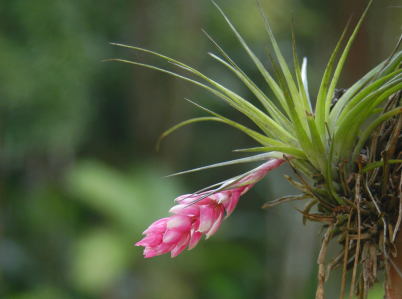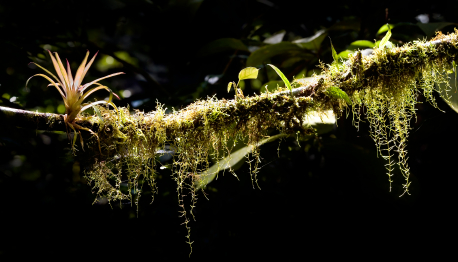Great Tips for Growing Epiphytes
Author: Celeste Booth4 Comments
Care and Culture, Growing Indoors
Many bromeliads are naturally epiphytes. Tillandsia, Vriesea, Neoregelia and Guzmania are all popular bromeliad genera that include many epiphytes. A famous example of an epiphytic bromeliad is spanish moss. It hangs from trees and telephone poles all around Southeastern United States. An epiphyte is a plant that grows attached to a substrate rather than on the ground in soil. Epiphytes commonly grow attached to trees, shrubs and other vegetation.
Epiphytes are not parasitic. They usually don’t not cause any damage to their substrate. Epiphytes take in all of the water and nutrients they need from the air around them, or indirectly from their substrate in the form of fallen leaves or debris.
UNIQUE CHARACTERISTICS

-Epiphyte growing in the rainforest.
Bromeliads that are epiphytes use their roots primarily as anchors. The roots grasp the substrate and fasten the plant securely to that substrate. They have special scales on their leaves called trichomes. The trichomes take in water from the air. Many epiphytic bromeliads also have a rosette shape that forms a central cup. The central cup collects water and debris that decomposes and provides nutrients. The central cup can also provide excellent habitat for many frogs, insects and other small creatures.
SPECIAL CARE
Because of their natural adaptations epiphytes have a few special care needs. They can be easily grown indoors attached to driftwood, mounted in terrariums or vivariums, or even mounted in ornaments and wreaths. Some epiphytes can also adapt to being planted terrestrially in a pot or container.
If you choose to plant an epiphyte in a container use a very well draining potting mix. Mixing in perlite or coarse sand will also help it drain quickly. Make sure the container does not stay soggy. Only water it when the first few inches of potting mix are dry. This will help you avoid root rot. Many Tillandsias cannot be potted terrestrially but must grow as an epiphyte.
SUBSTRATE
You can use a variety of substrates to mount your epiphyte. Choose something that will be rot resistant and salt free. You want to avoid woods that have been pressure treated or have stains on them. An article posted by the Bromeliad Society International suggests using pieces of cedar, juniper, oak or rosewood. Driftwood or cork bark can also work very well. You can easily find mounts at an aquarium or tropical plant specialty store.
You can mount small bromeliad species in glass orbs or directly onto suction cups that can be hung in your window. Woven grapevines or twisted branches can be used to craft living wreathes out of epiphytic plants. Online retailer, Tropiflora, suggests making a bromeliad “tree” if your climate permits. You can set a piece of wood in a container with cement so that it will stand firmly in place. Then hide the cement with river rocks or other top dressing. Mount the bromeliads to the wood using species that require similar amounts of light and water. With a little creativity you can craft some spectacular mounts.
PUPS
Next you want to choose a plant or plants. It is important to start a new mount with a pup or offshoot. Older plants that have grown terrestrially will not have the appropriate root system to act as strong anchors. Many smaller varieties of Tillandsias work well for smaller mounts such as ornaments and wreathes. Tillandsias also often form nice ball like clumps that look attractive when hung.
Smaller Vrieseas and Neoregelias are great additions to vivariums or terrariums. Large Neoregelias will be attractive mounted on trees or other large mounts outdoors, if your climate permits. If your temperatures drop below freezing regularly do not mount a bromeliad outdoors that cannot be easily moved inside.
MOUNTING

-An Epiphyte on a tree limb.
Plants with hardy stolons can be stapled directly to the mount. You can also tie plants on using wire or fishing line. The wire or line can be removed once the plant is firmly established. Make sure that any metal used does not include copper. Most bromeliads are extremely sensitive to any exposure to copper. Copper will quickly kill the plant. For smaller mounts and plants, use hot glue or liquid nails. If you use hot glue be sure to allow it to cool for a few seconds before adding the plant, so you don’t cause any damage to the sensitive leaves. Try to place only the root of the plant and not the leaves in the adhesive. Bromeliad Society International recommends tying up the plants with strips of old pantyhose for extra support until the plants have time to become firmly established.
CARE REQUIREMENTS
Many epiphytic bromeliads are adapted to the humid climates found in tropical rain forests. Some will need to be misted everyday to remain healthy. Most will prefer many hours of bright, but indirect sunlight. Direct light can often scorch bromeliad leaves. Take care not to let the air around the bromeliad become stagnate. If you place your mounts in a terrarium or vivarium, you may need to install a small fan to make sure that air circulates well.
WHEN TO MOUNT
It is possible to mount bromeliads anytime of year, but they may be the healthiest when planted at the beginning of the growing season. For most bromeliads the growing season is spring or early summer. This will allow the bromeliad to grow quickly and develop firm, substantial roots. This same process will take longer in the winter when bromeliads do not grow as rapidly.
To help large bromeliads become established quickly you may want to apply fertilizer right away. Brookreflections Bromeliads and Exotics suggests using a liquid fertilizer formulated for orchids as a spray to apply directly to the entire plant. Once the bromeliad is established it should no longer need the nutrients from fertilizer. Too much fertilizer can cause the plants to become gangly, discolored and may prohibited flowering. Smaller bromeliads should become established quickly without any feeding.
In the summer you can hang your mounts outside, from trees or attached to fences. Most bromeliads will enjoy the long hours of dappled shade found beneath a tree canopy. They will also prefer the higher humidity found outdoors in the summer. Outside, your bromeliads will require little attention. If there is no rain for several days in a row, you will want to soak the bromeliads occasionally.
ATTRACTIVE DISPLAYS
Mounted bromeliads can make excellent displays in your home, greenhouse, or even outdoor landscaping. Many will grow and multiply quickly to form large attractive clumps of healthy plants. Some will climb and propagate new plants through stolons. The new plants can be separated ocassionally to start new mounts. If you are growing a large bromeliad, wait until the pup is at least a third of the size of the mother plant before you remove it. Smaller Tillandsias can be separated individually or in small clumps. These plants will multiply quickly.
New mounts are great to share with friends and neighbors or to give as gifts. Well taken care of epiphytes will reward you with beautiful displays that continue to grow and produce for many seasons.
Sources
Head, Odean. “Mounting Bromeliads.” Bromeliad Society International.
“Bromeliads in the Trees.”Brookreflections Bromeliads & Exotics.
“Tropiflora’s Creating A Bromeliad Tree Replicating Nature in Your Garden.”Tropiflora.
4 Responses to “Great Tips for Growing Epiphytes”
Leave a Reply

Resource Download
Hechtia Care Cheat Sheet
Learn how to care for your Hechtia bromeliad with this quick and easy informational guide.
Learn More
Ask an Expert
Questions about bromeliads?
Our experts love a challenge!
Photo of the Week
Submit your photo to be featured on the blog!
More Photo of the Week Winners
Submit Photo








Trying to successfully incorporate epiphytes in a terrarium( aqua / terrestrial- they dont like too much moisture- im learning that.. Thanks for warning about copper- im using soldering wire to hang one…..
So… all of that and nothing on how to water them? I’ve read conflicting info all over the place – place plant in small dish of water with only roots touching the water and leave for an hour or so – immerse entire plant in water for 10 minutes, then place upside down to ‘drip-dry’ the upper portion – mist – never mist… So why nothing here? This is getting frustrating. I guess you have to kill a few before you get it right, sigh.
I have several tillandsia, I just soak them in room temperature water fit a few hours every 4 days. I have chlorinated water, so I let it sit out to evaporate the chlorine, then put my plant in it. When I take them out I make sure to put them upside down until they are dry- water trapped at the base of the leaflets causes rot and death (I killed one by not doing this, I sonetime will blow out the extra water trapped in the leaves) then once dry, put them back for another 4 days
I’ve just obtained a small quarter sized epiphyte from the Bahamas whose mother plant can be almost 2feet height clung to a tree. Any advice on care? Currently it is in a jar with a damp piece of paper towel nearby, the house is very dry